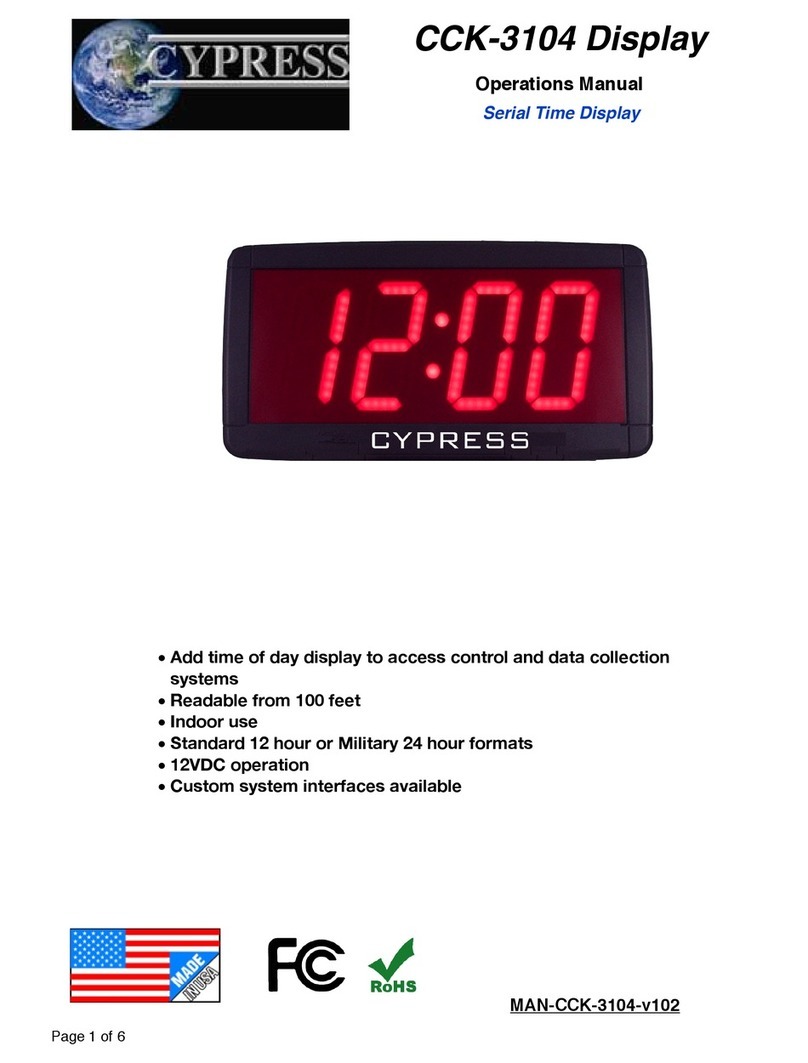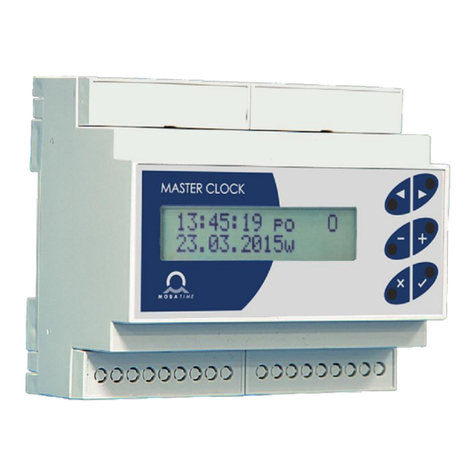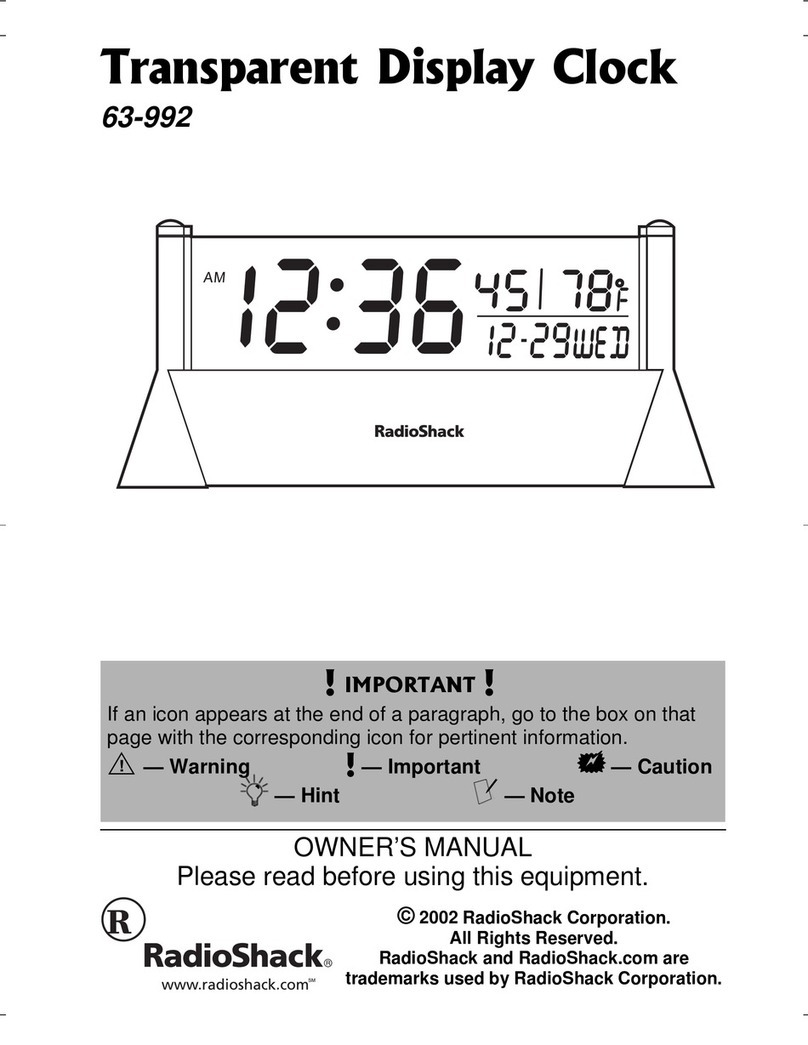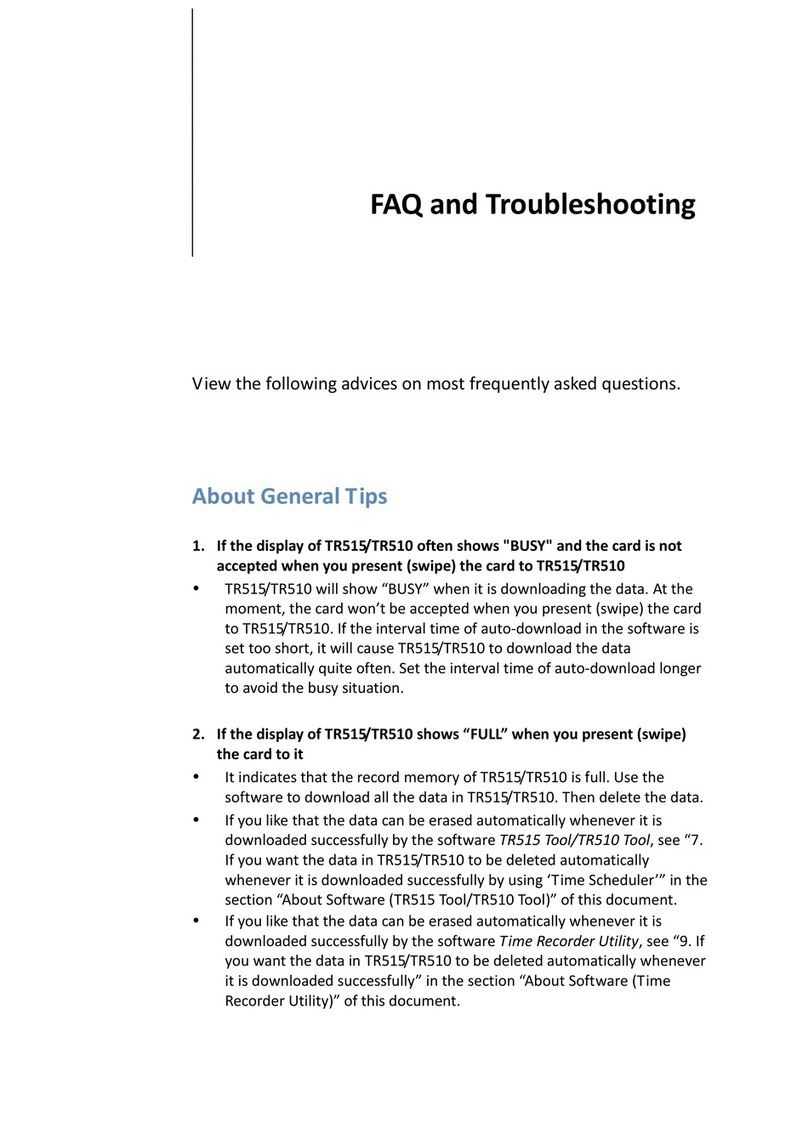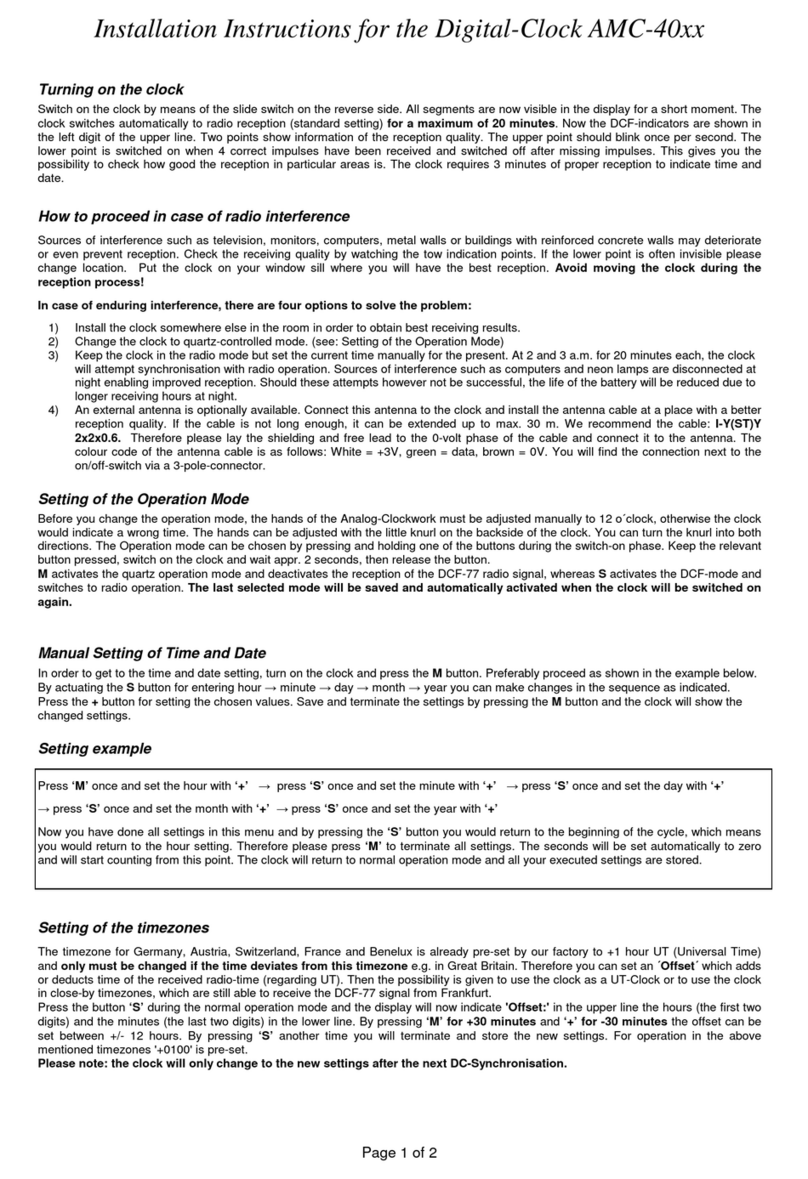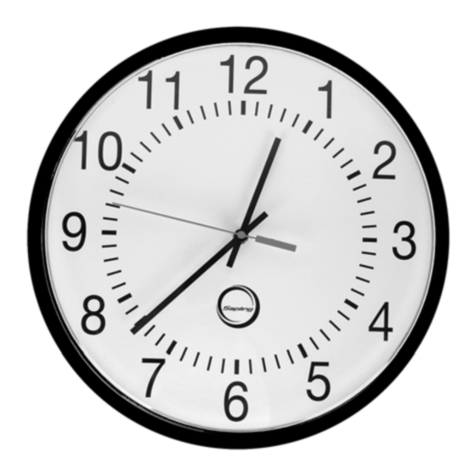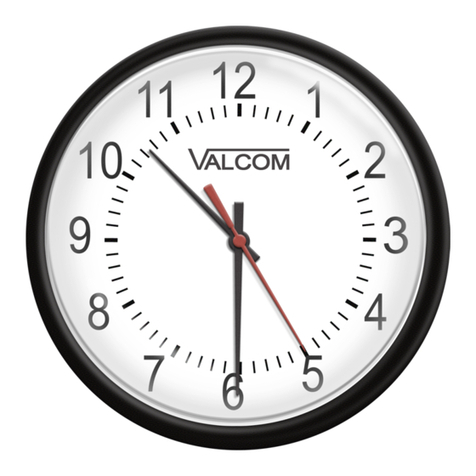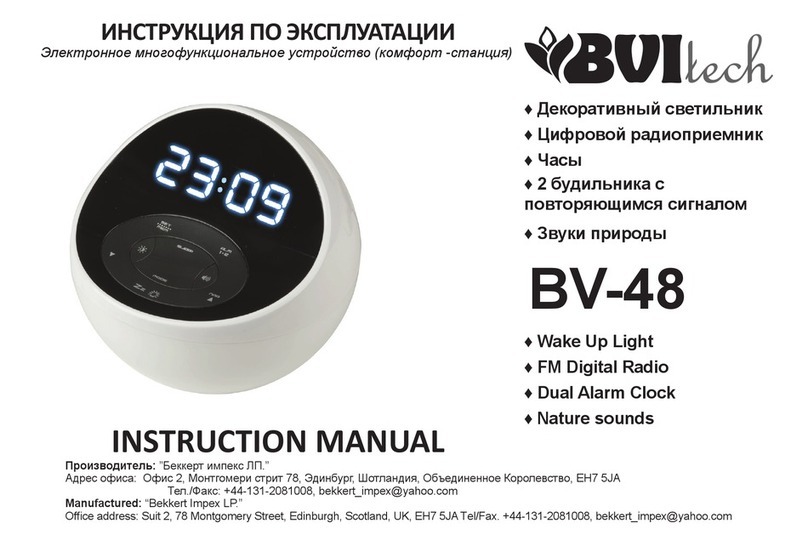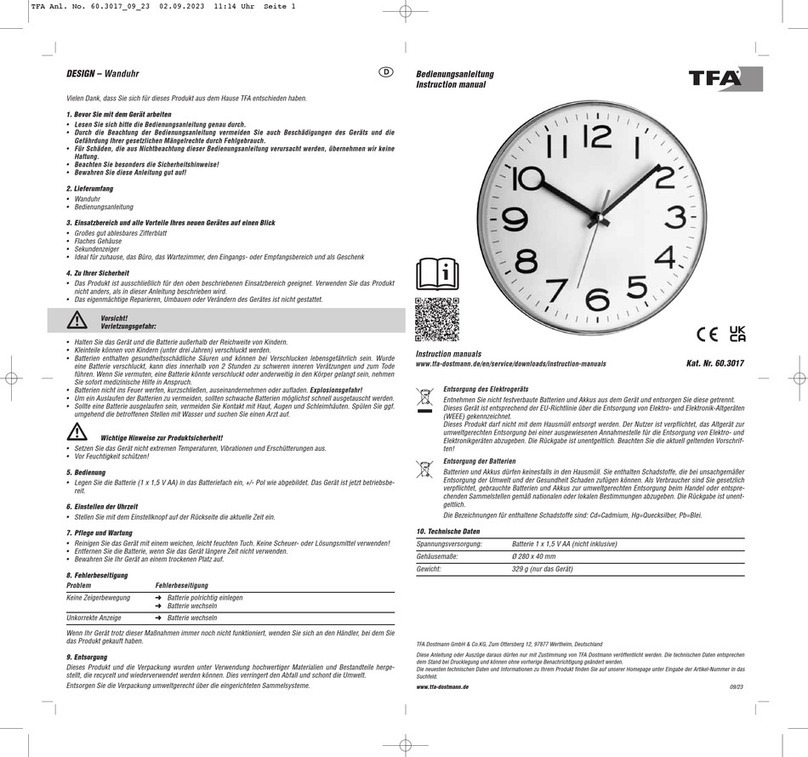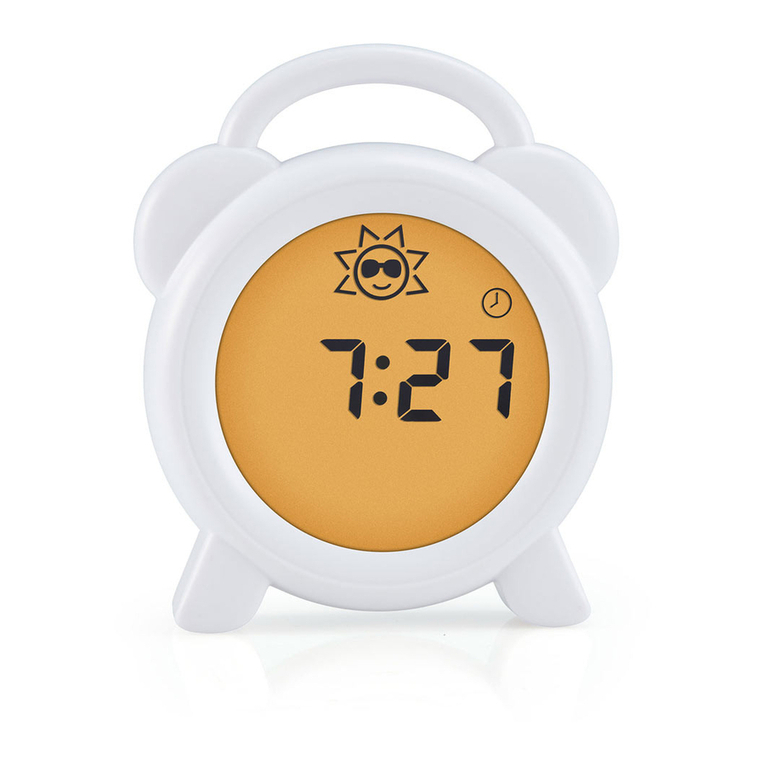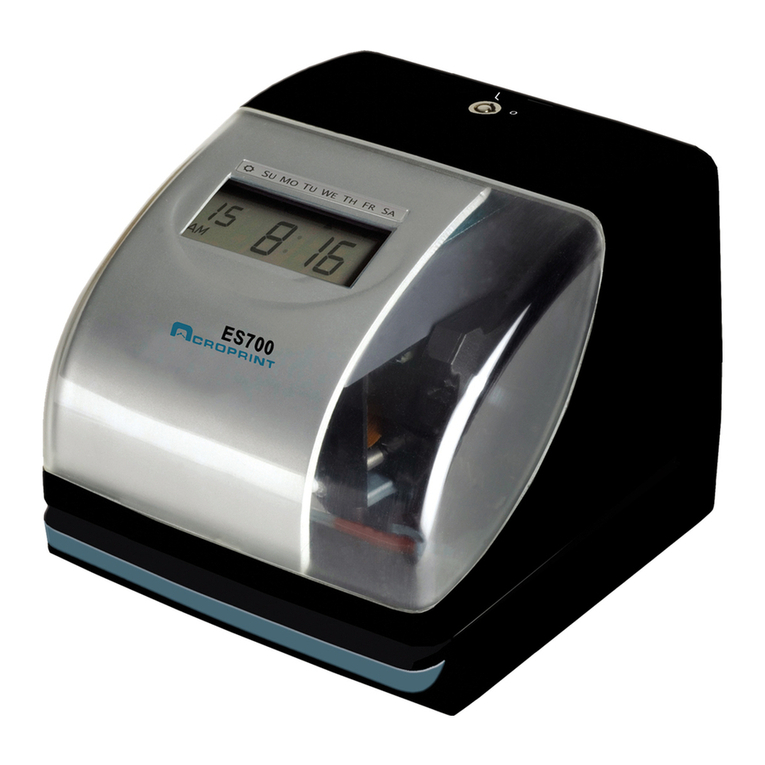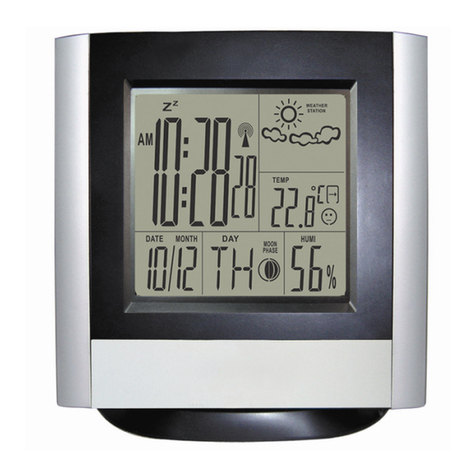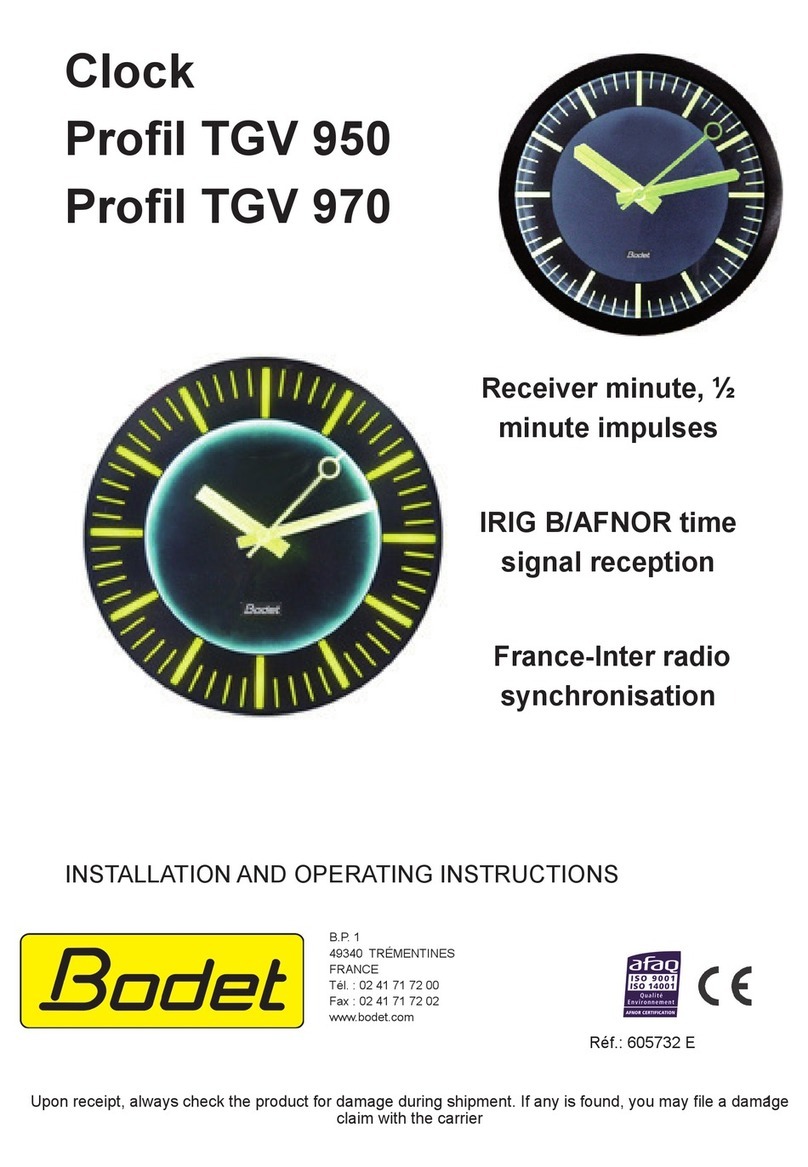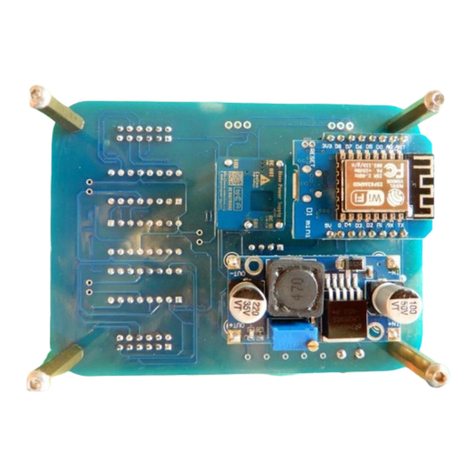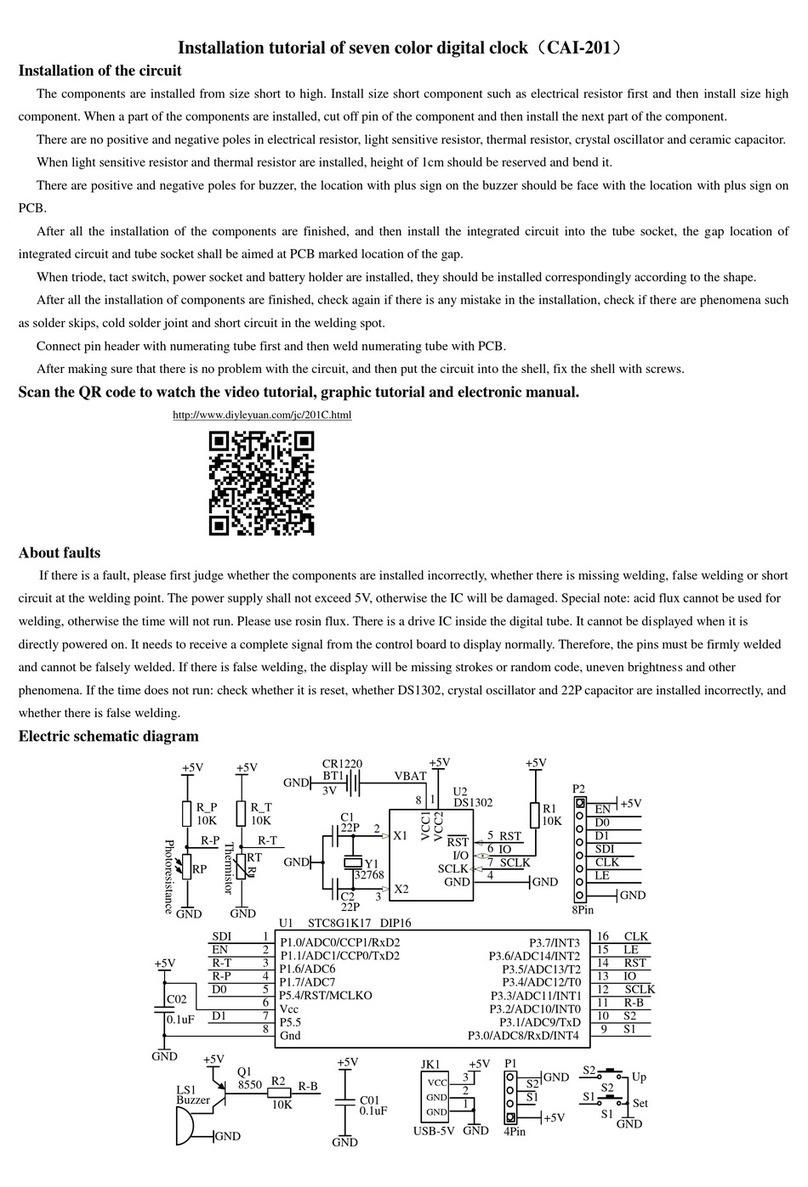PROTMEX PT20C User manual

PT20C Weather Station Clock
WWVB RCC/NO RCC Version
User Manual

1
1. Functional Overview
1) Perpetual calendar;
2) RCC function (Only RCC version weather station has this function);
3) Multi-time zone clock, WWVB version supports time zones is US time zone
(Only RCC version weather station has this function);
4) Weekly display, support 7 languages (English, German, Italian, French,
Spanish, Dutch, Danish)
5) Personalized alarm clock, can be set to ring on weekdays, weekends or every
day, and has a snooze alarm clock function;
6) Moon phase;
7) Weather forecast function;
8) Temperature and humidity measurement function, support Celsius and
Fahrenheit;
9) The temperature measurement range of the signal receiver: -9.9℃~50 ℃
(14.2℉~122℉); when the temperature is higher than 50℃, the screen will
display “HH.H”; when it is lower than -9.9℃, it will display “LL.L” ";
10) Wireless sensor temperature measurement range: -40°C to 70°C (-40°F~
158 ° F); when the temperature is higher than 70 ° C, the screen displays
"HH.H"; when it is lower than -40°C, it displays "LL.L" ";
11) Receiver and sensor humidity measurement range: 20-99%; when the relative
humidity of the air is higher than 99%, the screen displays "HH"; when it is
lower than 20%, it displays "LL";

2
12) Air pressure measurement range: 800~1100 hPa, error range: ±2hPa, and
the supported unit systems are: hPa / mb / inHg / mmHg;
13) The data trend of indoor and outdoor temperature/humidity/air pressure;
14) Maximum and minimum temperature and humidity recording function;
15) Dew point temperature;
16) Frost alarm function;
17) Temperature alarm function;
18) Heat index;
19) Indoor comfort graded expressions;
20) The PT20C signal receiver can connect up to 3 signal sensors at the same
time, and display the data of each sensor on the receiver screen in a carousel
mode;
21) Low battery alarm;
22) LCD backlight;
23) Power supply: The receiver needs 3 batteries with a specification of "AAA (LR
03)" or a power input with a specification of "DC 5V"; the wireless sensor only
needs 2 batteries with a specification of "AAA (LR 03)".

3
2. Appearance & Screen Display Introduction
1) Snooze alarm clock and backlight wake up, touch sensing area;
2) LCD display;
3) Power adapter socket;
4) Alarm clock switch
5) "▲/RF" key;
6) "TIME" key;
7) "▼/MEM" key;
8) Hook up hole;
9) "HI/DP" key;
10) “ALARM” Key;
11) “ALERT” Key;
12) Folding support frame;
13) Battery compartment.

4
1) LCD Screen;
2) °C / °F Switch Button;
3) Hanging Hole;
4) Channel Switch Button;
5) Transmit signals immediately;
6) Battery compartment;
7) Support piece.

5
1) Frost alarm;
2) Weather forecast;
3) Temperature alarm;
4) Signal channel;
5) The maximum and minimum outdoor temperature and humidity;
6) Sensor low battery alarm;
7) Outdoor temperature;
8) Outdoor temperature change trend;
9) Outdoor dew point temperature;
10) Outdoor heat index;
11) Outdoor humidity change trend;

6
12) Outdoor relative humidity;
13) Date;
14) Moon phase;
15) Weekly display;
16) The maximum and minimum indoor temperature and humidity;
17) Signal receiver low battery alarm;
18) Indoor temperature change trend;
19) Indoor relative humidity change trend;
20) Indoor relative humidity;
21) Graded expressions of indoor comfort;
22) Indoor temperature
23) Alarm clock;
24) Time;
25) Daylight saving time (only WWVB version);
26) Time zone (only RCC version);
27) RCC signal (only RCC version);
28) Air pressure;
29) Air pressure change trend.

7
1) Temperature;
2) Celsius or Fahrenheit units;
3) Sensor low battery alarm;
4) Relative humidity;
5) Signal channel.
3. Power On & Reset
When the signal receiver is powered on or reset, the full screen display lasts for 3
seconds, and the backlight is on. Then, the buzzer emits a beep to detect and
display the real-time indoor temperature and humidity. At the same time, enter
the RF signal receiving state, automatically search for and connect to nearby
signal sensors, and automatically enter the RCC search and receive state;

8
After power on, the screen display will display the content by default, as shown in
the following table:
4. Setup & Operation
The relationship between keys and operations is shown in the following table:
version
Display type
display
time
Mont
h/Day
date
Default
language of
the week
Tempera
ture unit
Time
zone
AL1 time
AL2 time
WWVB RCC US
12:00AM
(12 hour
clock)
M/D
January 1st , 2021
English
℉
EST
7:00AM,
Off by
default
1:30PM,
Off by
default
WWVB NO RCC US
12:00AM
(12 hour
clock)
M/D
January 1st , 2021
English
℉
NO
7:00AM,
Off by
default
1:30PM,
Off by
default
operating
button
【TIME】
【ALARM
】
【ALERT】
【HI/DP】
【▲/RF】
【▼/MEM】
【SNOOZE/LI
GHT】
Alarm clock
toggle
switch
General
mode
Single
press
------
Switch
time/alarm
1/alarm 2
temperatur
e alarm
on/off
Switch
current
temperature
/heat
index/dew
point
temperature
Switch display of CH1,
CH2, CH3 temperature
and humidity
Switch to view
current/maximu
m/minimum
temperature and
humidity
Turn on the
backlight /
switch
brightness
level
Alarm clock
on&off/Soun
d on&off
Keep
pressi
ng
Enter
setting
mode
Enter
alarm
settings
Enter
temperatur
e alarm
setting
Temperature
unit switch
Clear outdoor channel
data and search signal
again
Maximum and
minimum
interface clear
memory value
RCC
receive/stop(O
nly RCC
version)
------
Setting
mode
Single
press
Select
setting
item/Con
firm
setting
Select
setting
item/Confi
rm setting
Select
setting
item/Confir
m setting
------
Single step increment
Single step
decrement
------
------
Keep
pressi
ng
-----
------
------
------
8 steps/sec increment
8 steps/sec
decrement
------
------

9
Time setting: long press the "TIME" button for two seconds, the specific process
is shown in the following table:
Note:
1) The week changes with the year, month and day;
2) The annual setting range is 2020~2099;
3) The second returns to zero when the minute is set;
4) Single press the "TIME" key to confirm the setting result and move to the next
setting item;
5) Single press the "▲/RF" key to set the item one step forward; long press for
more than 2 seconds, it will advance at the speed of 8 steps per second;
6) Single press the "▼/MEM" key to go back one step of the setting item; long
press for more than 2 seconds, it will go back at 8 steps per second;
7) No operation within 20 seconds will save the settings and exit the setting
mode;
WWVB
RCC US
Weather
pattern→
RCC
ON/OFF
→
Time
zone
→
Lang
uage
→
12/24H
→
hour
→
min
ute
→
year
→
DM/MD
→
month→
day
→
Air
pressure
value
unit→
DST
on/off
→
drop
out
WWVB NO
RCC US
Weather
pattern→
Language
→
12/24
H→
hour
→
minute
→
year
→
DM/
MD
→
mon
th→
day→
Air
pressure
value
unit→
drop
out
/
/
/

10
8) Time zone description(Only RCC Version):
9) The week display comparison of different languages is shown in the following
table:
Alarm setting:
1) Single press the "ALARM" button to view the preset ringing time of Alarm 1
and Alarm 2 respectively;
2) Long press the "ALARM" key to enter the alarm setting mode, the setting
process is shown in the following table:
Sequence of steps
Screen display
Operating
The first step
Single press "▲/RF" or "▼/MEM" to
select on or off alarm 1;
The second step
Single press the "ALARM" key to confirm
the setting and enter the next step;
The third step
Single press "▲/RF" or "▼/MEM" to set
the "hour" in the ring time, and single
press the "ALARM" key to confirm the
setting;
WWVB
Eastern – EST (GMT -5)
Central – CST (GMT -6)
Mountain – MST (GMT -7)
Pacific – PST (GMT -8)
Language
abbreviation
Sunday
Monday
Tuesday
Wednesday
Thursday
Friday
Saturday
English
EN
SUN
MON
TUE
WED
THU
FRI
SAT
German
DE
SON
MON
DIE
MIT
DON
FRE
SAM
Italian
IT
DOM
LUN
MAR
MER
GIO
VEN
SAB
French
FR
DIM
LUN
MAR
MER
JEU
VEN
SAM
Spanish
ES
DOM
LUN
MAR
MIE
JUE
VIE
SAB
Netherlands
NL
ZON
MAA
DIN
WOE
DON
VRI
ZAT
Denmark
DA
SON
MAN
TIR
ONS
TOR
FRE
LOR

11
The fourth step
The key operation is the same as the
third step, this step sets the "minute" in
the ringing time;
The fifth step
Single press "▲/RF" or "▼/MEM" to
select the alarm repeat mode, and
single press "ALARM" key to confirm
the setting.
* The light-colored part of the on-screen text in the table indicates that the
character is flashing at that time.
3) The setting method of alarm 2 is the same as alarm 1;
4) There are three types of alarm clock repetitions: "1-7", "1-5", and "6-7", which
represent "Daily ring", "Only ring from Monday to Friday", "Only ring from
Saturday to Sunday";
5) When setting the alarm, single press the "▲ /RF" key to increase the setting
item by one unit; long press it, the setting item will increase at a rate of 8 units
per second;
6) When setting the alarm, single press the "▼/MEM" key to decrease the setting
item by one unit; long press it, the setting item will decrease at a rate of 8 units
per second;
7) Without any operation within 20 seconds, the settings are automatically saved
and the setting mode is exited.
Outdoor temperature alarm settings:
1) Single press the "ALERT" key to choose to open or close the temperature
alarm function;

12
2) Long press the "ALERT" key to enter the temperature alarm setting mode, and
the following specific steps are shown in the below table:
Sequence of steps
Screen display
Operating
First step
Single press "▲/RF" or "▼
/MEM" to set the upper limit of
temperature alarm; single
press "ALERT" key to confirm
the setting and go to the next
step;
Second step
The operation is the same as
the first step. This step sets the
lower limit of the temperature
alarm.
* The light-colored part of the on-screen text in the table indicates that the
character is flashing at that time.
Screen backlight:
1) In the state of power supply, after power on or reset, the LCD backlight will
highlight for 30 seconds and then go off; if want to wake up, just touch the
"SNOOZE / LIGHT" sensing area on the top of the signal receiver;
2) When the alarm clock rings, the LCD backlight will be turned off automatically
after 30 seconds of highlighting;
3) Under the power supply state of the power adapter, the LCD backlight remains
bright;
4) In the power supply state of the power adapter, touch the "SNOOZE / LIGHT"
sensing area on the top of the signal receiver to change the backlight brightness,
and switch between the three states of "strong → weak → off".

13
5、Function & Effect Description
(1) RCC, with automatic RCC receiving function (Only for RCC version).
Receiving conditions for entering RCC:
a) After power on or reset, it automatically enters RCC reception;
b) Long press the "SNOOZE/LIGHT" button to forcibly enter RCC reception;
c) During the receiving process, long press the "SNOOZE/LIGHT" button to stop
RCC receiving;
d) Daily RCC timing automatic receiving time: automatic mandatory reception at
1:03, 2:03, 3:03 every morning, and selection at 4:03, 5:03;
RCC receiving time lasts about 3~8 minutes
RCC receiving graphics:
a) The symbol flashes when entering reception;
b) The reception is successful, and the entire RCC reception symbol is
continuously displayed;
c) When the signal reception is unsuccessful, the symbol will disappear and RCC
will exit.
(2) RF function:
After installing the battery it detect the temperature and humidity. it will
automatically enter the RF reception for 3 minutes, and then enter the RCC
reception after 3 minutes;
In the standard mode, long press the "▲/RF" key to forcefully clear all outdoor
channel data and re-receive; the connected CH temperature does not receive

14
the valid signal of the same ID Code within 60 minutes, the CH temperature will
display "-- .-"
When the temperature is lost, the signal is received again and the temperature
display will be restored
(3) Alarm function:
The alarm time lasts for 2 minutes;
When the alarm is sounding, single press [SNOOZE/LIGHT] key to delay the
alarm for 5 minutes, press other keys to exit the alarm;
The maximum number of alarms is 5;
(4) Temperature function:
Indoor temperature range: -9.9℃ ~ 50℃ (14.2℉ ~ 122℉); higher than 50℃
shows HH.H, lower than -9.9℃ shows LL.L;
Outdoor temperature range: -40℃ ~ 70℃ (-40℉ ~ 158℉); higher than
70℃ shows HH.H, lower than -40℃ shows LL.L;
Indoor and outdoor environmental humidity range: 20-99%; higher than 99%
shows HH, lower than 20% shows LL;
Indoor temperature detection cycle: 30 seconds;
Outdoor temperature and humidity:
a) CHANNEL 1 periodically transmits 93S once;
b) CHANNEL 2 is periodically transmitted once at 97S;
c) CHANNEL 3 is launched once every 101s;
d) Temperature and humidity maximum/minimum memory function, long press

15
"▼/MEM" to clear the memory value or clear the memory value at 0 o'clock
every day to the current value;
e) Temperature error range: ±1℃; humidity error range ±5%;
When the alarm clock rings or RCC reception is in progress, the temperature
detection is suspended.
(5) Outdoor temperature alarm
The default highest temperature alarm value is +40℃ (+104℉), and the low
temperature alarm value is -10℃ (+14℉);
When it is not the current display channel alarm, only the alarm sounds, the
alarm symbol and temperature display do not flash;
Temperature alarm sound: BiBiBiBi, BiBiBiBi once every minute, the
corresponding alarm icon flashes;
During the alarm period, just press the "ALERT" key to turn off the temperature
alarm function, then the alarm and icon flashing can be terminated, and the
temperature screen display in this area will return to the normal display state.
(6) Indoor comfort
Comfort expression
Comfort state
Corresponding humidity
range
Comfortable
40% ~ 69%
Dry
≤39%
Wet
≥70%

16
(7) Frost alarm function
When the signal sensor of channel 1 is in the environment where the
temperature is less than 3℃ and greater than -2℃, the frost alarm icon " " is
displayed; when the temperature changes outside this range, the icon
disappears.
(8) Heat index and dew point temperature
As shown in the following table, the relationship between the heat index and the
temperature value, and the matters needing attention:
Single press the "HI/DP" key to check the heat index, and then press the key
again to check the dew point temperature;
Temperature in
Fahrenheit
Celsius
Things to note
80 ~ 90°F
27 ~ 32°C
Warning-too long exposure and activity may cause fatigue
90 ~ 105°F
32 ~ 41°C
Serious warning-may cause heat stroke, heat cramps and h
eat exhaustion
105 ~ 130°F
41 ~ 54°C
Danger—very likely to cause heat stroke, heat cramps, and
heat exhaustion; may cause severe heat stroke
Over 130°F
Over 54°C
Extremely dangerous-continuous sun exposure is extremely
likely to cause heat stroke and severe heat stroke

17
(9) Moon phase function (positive display: northern hemisphere image)
The monthly image of the day is automatically calculated according to the
calendar, as shown below:
Moon phase icon
Moon phase name
Full Moon
Waning Gibbous
Third Quarter
Waning Crescent
New Moon
Waxing Crescent
First Quarter
Waxing Gibbous

18
(10) Weather forecast, as shown in the following table:
Screen display
Corresponding weather
Sunny
Partly Cloudy
Cloudy
Rainy
Thunder Shower
Snowy
Heavy Snow

Table of contents
